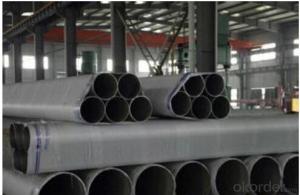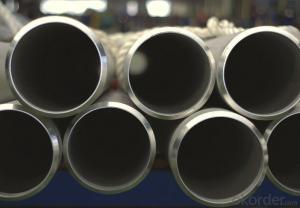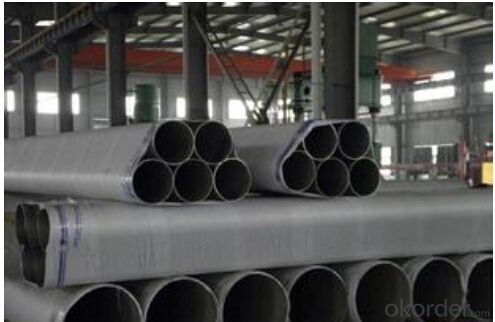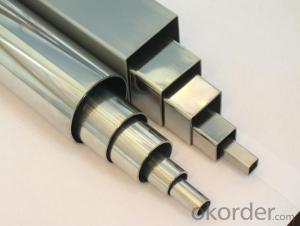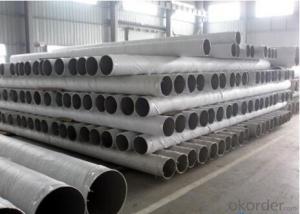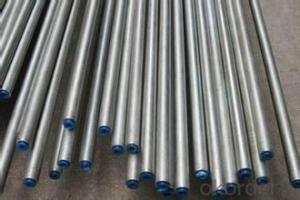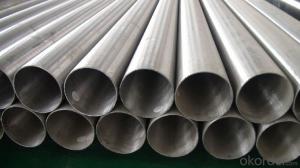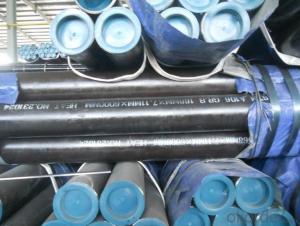Stainless Steel Seamless Pipe 316 ASTM A312
- Loading Port:
- Ningbo
- Payment Terms:
- TT OR LC
- Min Order Qty:
- 1 m.t.
- Supply Capability:
- 5000 m.t./month
OKorder Service Pledge
OKorder Financial Service
You Might Also Like
1、Structure of Stainless Steel Seamless Pipe 316 ASTM A312 Description:
Stainless seamless pipe is formed by drawing a solid billet over a piercing rod to create the hollow shell. As the manufacturing process does not include any welding, seamless pipes are perceived to be stronger and more reliable. Historically seamless pipe was regarded as withstanding pressure better than other types, and was often more easily available than welded pipe.
2、Main Features of the Stainless Steel Seamless Pipe 316 ASTM A312:
• High manufacturing accuracy
• High strength
• Small inertia resistance
• Good visual effect
•Reasonable price
3、Stainless Steel Seamless Pipe 316 ASTM A312 Images:
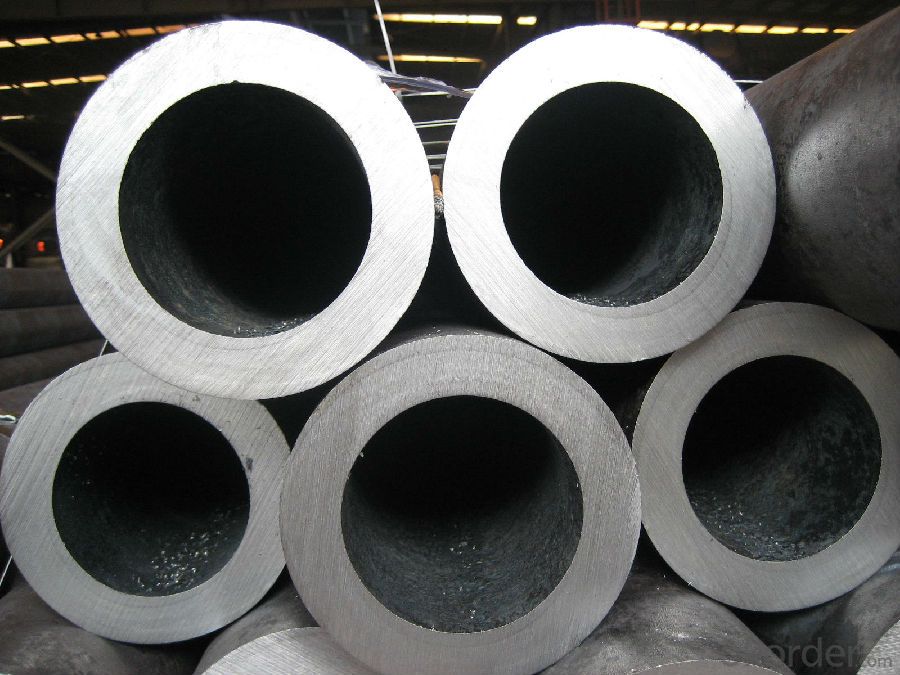
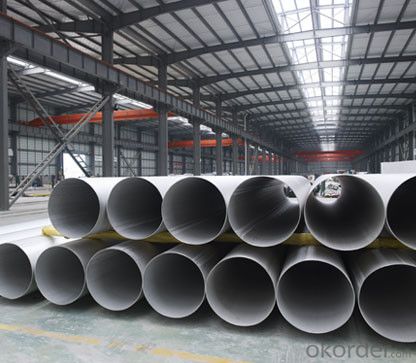
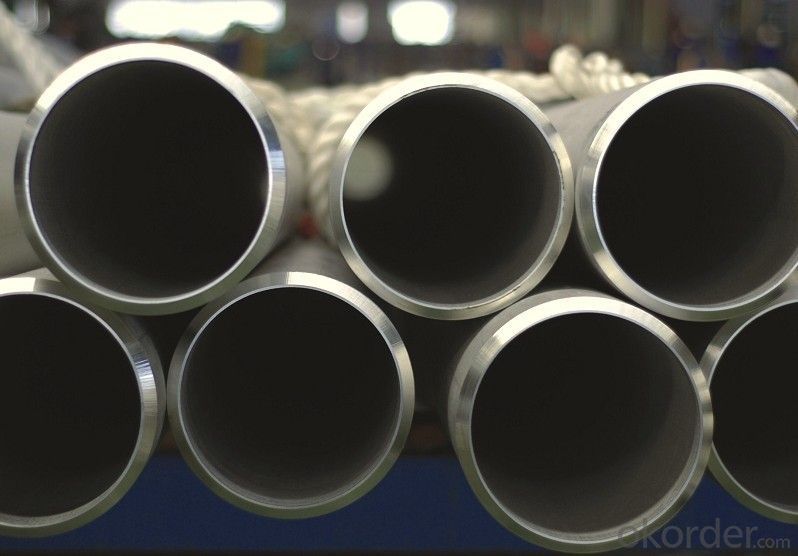
4、Stainless Steel Seamless Pipe 316 ASTM A312 Specification:
| Standard | ASTM A213/A213M-06,ASTM A312/A312M-06, ASTM A376/A376M-06,ASTM A789/A789M-05b, ASTM A790/A790M-05b,ASTM A268/A268M-05a, ASTM A269 |
GB/T 13296-2007,GB/T 14976-2002 | |
| JIS G3459-2004,JIS G3163-2006,JIS G3467-1988 | |
| Material : | 201,202 ,304,304L,304N,304LN,301,305,309S,310S,316,316L,316N,316LN,316Ti 317,317L,321,347, 321h,347,904L,2205,S31803, |
| Dimension: | 5*5mm~150*150mm |
| Thickness : | 0.4mm~80mm |
| Length : | 3m,4m,5.8m,6m,12m or as required |
| Surface : | Annealing ,polish,pickling,bright ,sand blast ,etc |
| Packing: | Standard export seaworthy package or as customer's demand |
| Application: | petroleum ,chemical industry,bolier ,heat exchange,high temperature resistant transmission, fluid pipe in power station,ship with pressure pipe,construction and so on. |
| Delivery: | prompt delivery |
| Quality control: | Mill Test Certificate is supplied with shipment.Third Part Inspection is also acceptable |
5、FAQ of Stainless Steel Seamless Pipe 316 ASTM A312:
①How is the quality of your products?
Our products are manufactured strictly according to national and internaional standard, and we take a test
on every pipe before delivered out. If you want see our quality certifications and all kinds of testing report, please just ask us for it.
Guaranteed: If products’ quality don’t accord to discription as we give or the promise before you place order, we promise 100% refund.
②How about price?
Yes, we are factory and be able to give you lowest price below market one, and we have a policy that “ for saving time and absolutely honest business attitude, we quote as lowest as possible for any customer, and discount can be given according to quantity”,if you like bargain and factory price is not low enough as you think, just don’t waste your time.Please trust the quotation we would give you, it is professional one.
③Why should you chose us?
Chose happens because of quality, then price, We can give you both.Additionally, we can also offer professional products inquiry, products knowledge train(for agents), smooth goods delivery, exellent customer solution proposals.Our service formula: good quality+good price+good service=customer’s trust
SGS test is available, customer inspection before shipping is welcome, third party inspection is no problem.
Any question, pls feel free to contact us !
- Q: Can stainless steel pipes be chromed?
- Yes, stainless steel pipes can be chromed. The process involves applying a thin layer of chromium onto the surface of the stainless steel pipes, which not only enhances their appearance but also provides increased resistance to corrosion.
- Q: Can stainless steel pipes be used in underground installations?
- Yes, stainless steel pipes can be used in underground installations. Stainless steel is a highly durable and corrosion-resistant material, making it suitable for underground applications where the pipes are exposed to moisture and other environmental factors. Additionally, stainless steel pipes have high strength and can withstand pressure, making them a reliable choice for underground installations.
- Q: 304 stainless steel tube with the diameter of 25*2-3 is what mean
- 304 stainless steel tube with the diameter of 25*2-3 said: material for 304 (the equivalent of the American brand, Chinese numbered S30408 stainless steel or 06Cr19Ni10 stainless steel), diameter (OD) for 25mm, for the seamless steel pipe wall thickness of 2 to 3mm.
- Q: What is the external protection used for stainless steel pipes?
- The external protection used for stainless steel pipes primarily involves the application of a protective coating or treatment to prevent corrosion and maintain the integrity of the pipes. This is important because even though stainless steel is known for its resistance to corrosion, it is still susceptible to environmental factors and can corrode under certain conditions. One commonly used external protection method is the application of a corrosion-resistant coating such as epoxy, polyethylene, or zinc. These coatings act as a barrier between the stainless steel pipe and the surrounding environment, preventing direct contact and potential corrosion. The coating also helps to protect the pipe from physical damage, such as scratches or abrasions, that could lead to corrosion. Another method of external protection is the use of cathodic protection, which involves the placement of sacrificial anodes or the application of an electric current to the stainless steel pipe. This process helps to direct the corrosion away from the pipe by sacrificing the anodes or by creating an electrochemical reaction that inhibits corrosion. Additionally, external protection may also involve the use of insulation materials to prevent condensation and moisture buildup on the pipe's surface. Moisture can accelerate corrosion, so proper insulation can help maintain the integrity of the stainless steel pipes. Overall, the external protection used for stainless steel pipes aims to prevent corrosion and maintain the longevity and reliability of the pipes. By implementing various protective coatings, cathodic protection, and insulation, stainless steel pipes can be safeguarded from environmental factors and ensure their optimal performance.
- Q: Can stainless steel pipes be used for food processing applications?
- Yes, stainless steel pipes can be used for food processing applications. Stainless steel is a highly corrosion-resistant material that is non-reactive and does not impart any taste or odor to the food being processed. It is also easy to clean and maintain, making it a suitable choice for ensuring food safety and hygiene in processing environments.
- Q: Can stainless steel pipes be used for pharmaceutical cleanrooms?
- Yes, stainless steel pipes can be used for pharmaceutical cleanrooms. Stainless steel is a widely used material in cleanroom environments due to its excellent corrosion resistance, durability, and ease of cleaning. It is non-porous and does not harbor bacteria, making it suitable for pharmaceutical applications where cleanliness and hygiene are crucial. Stainless steel pipes also have high temperature and pressure resistance, making them suitable for various processes and applications within pharmaceutical cleanrooms. Additionally, stainless steel pipes can be easily welded and joined, ensuring a seamless and hygienic system.
- Q: What are the different sizes available for stainless steel pipes?
- Various industrial and residential applications can be catered to with a wide range of sizes of stainless steel pipes. The sizes of stainless steel pipes typically depend on their nominal pipe size (NPS) or outside diameter (OD). The diameter of stainless steel pipes commonly ranges from 1/8 inch to 48 inches. For smaller applications or plumbing systems, stainless steel pipes with NPS 1/8, 1/4, 3/8, and 1/2 are commonly utilized. These sizes are suitable for household plumbing, water supply lines, and low-pressure applications. As the requirements increase, larger stainless steel pipe sizes are available. Sizes such as NPS 3/4, 1, 1 1/4, 1 1/2, and 2 inches are commonly employed in various industries and commercial applications. These sizes are appropriate for higher-pressure applications like hydraulic systems, oil and gas pipelines, and chemical processing plants. For industrial applications that demand even larger pipes, stainless steel pipes with sizes ranging from 2 1/2 inches to 48 inches in diameter are accessible. These large pipes are frequently used in heavy-duty applications such as petrochemical plants, power generation facilities, and large-scale construction projects. It's important to note that stainless steel pipes are also obtainable in different wall thicknesses, known as schedules. The schedule number determines the wall thickness, with higher numbers indicating thicker walls. The most common schedules for stainless steel pipes are Schedule 5, Schedule 10, Schedule 40, and Schedule 80. In conclusion, a wide range of sizes are available for stainless steel pipes, starting from 1/8 inch and going up to 48 inches in diameter. The appropriate size selection depends on the specific application and the required pressure and flow requirements.
- Q: What is the difference between seamless and SAW stainless steel pipes?
- The main difference between seamless and SAW (Submerged Arc Welding) stainless steel pipes is the method of manufacturing. Seamless pipes are formed by piercing a solid billet of steel to create a hollow tube without any welding involved. On the other hand, SAW pipes are made by continuously welding the edges of a steel plate or strip to form a pipe. This welding process can result in a visible seam along the length of the pipe. While both types of pipes offer high corrosion resistance and strength, seamless pipes are generally preferred for applications requiring higher pressure, precise dimensions, and a smoother inner surface, whereas SAW pipes are commonly used for less critical applications where cost and availability are more important factors.
- Q: Stainless steel pipes can not be less than the amount of chromium
- The chromium content of stainless steel is generally not less than said first why stainless steel tube is not easy to rust 12%-304 stainless steel tube, then why stainless steel will rust stainless steel is not easy to have a great relationship with the composition of stainless steel rust. In addition to iron, stainless steel contains chromium, nickel, aluminum, silicon and so on.
- Q: What is passivation in stainless steel pipes?
- Passivation in stainless steel pipes refers to the process of treating the surface of the pipes to remove any contaminants and enhance its corrosion resistance properties. It involves the use of chemical solutions or acids to remove iron particles and other impurities from the surface, creating a protective oxide layer that prevents further corrosion.
Send your message to us
Stainless Steel Seamless Pipe 316 ASTM A312
- Loading Port:
- Ningbo
- Payment Terms:
- TT OR LC
- Min Order Qty:
- 1 m.t.
- Supply Capability:
- 5000 m.t./month
OKorder Service Pledge
OKorder Financial Service
Similar products
Hot products
Hot Searches
Related keywords
